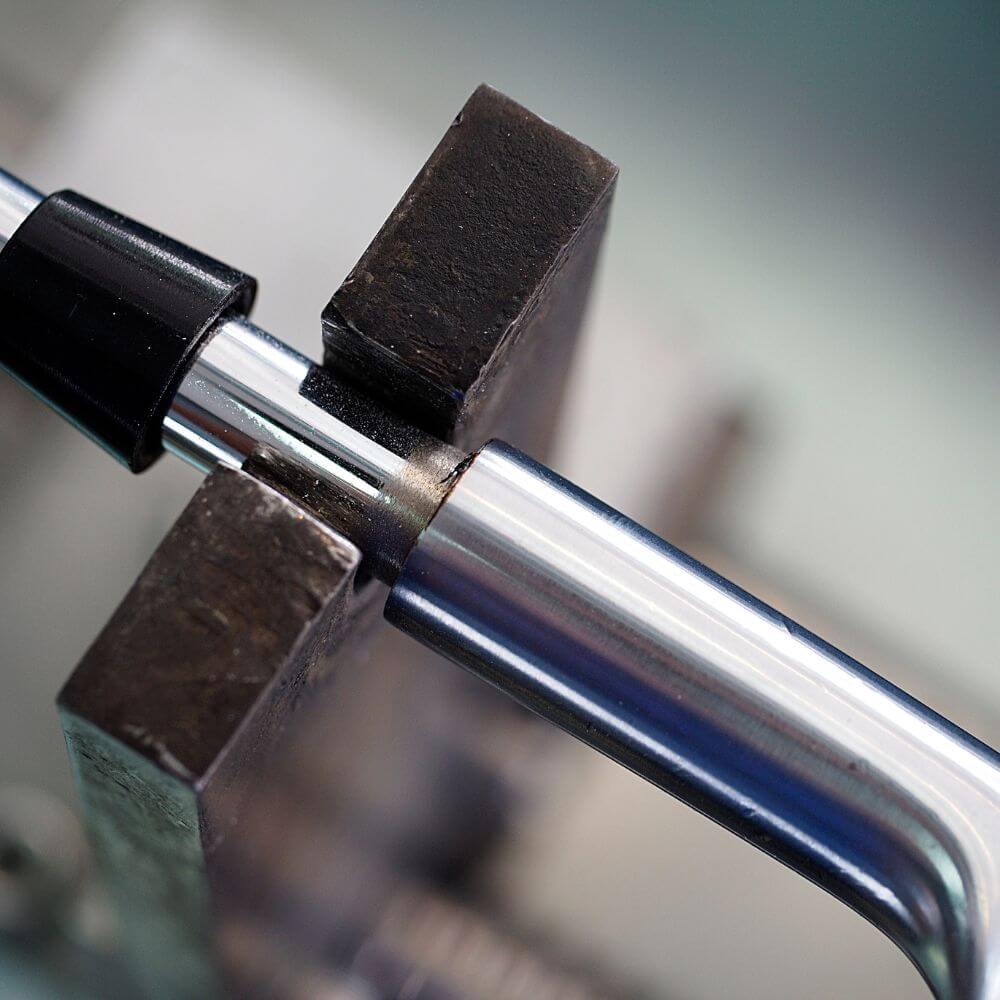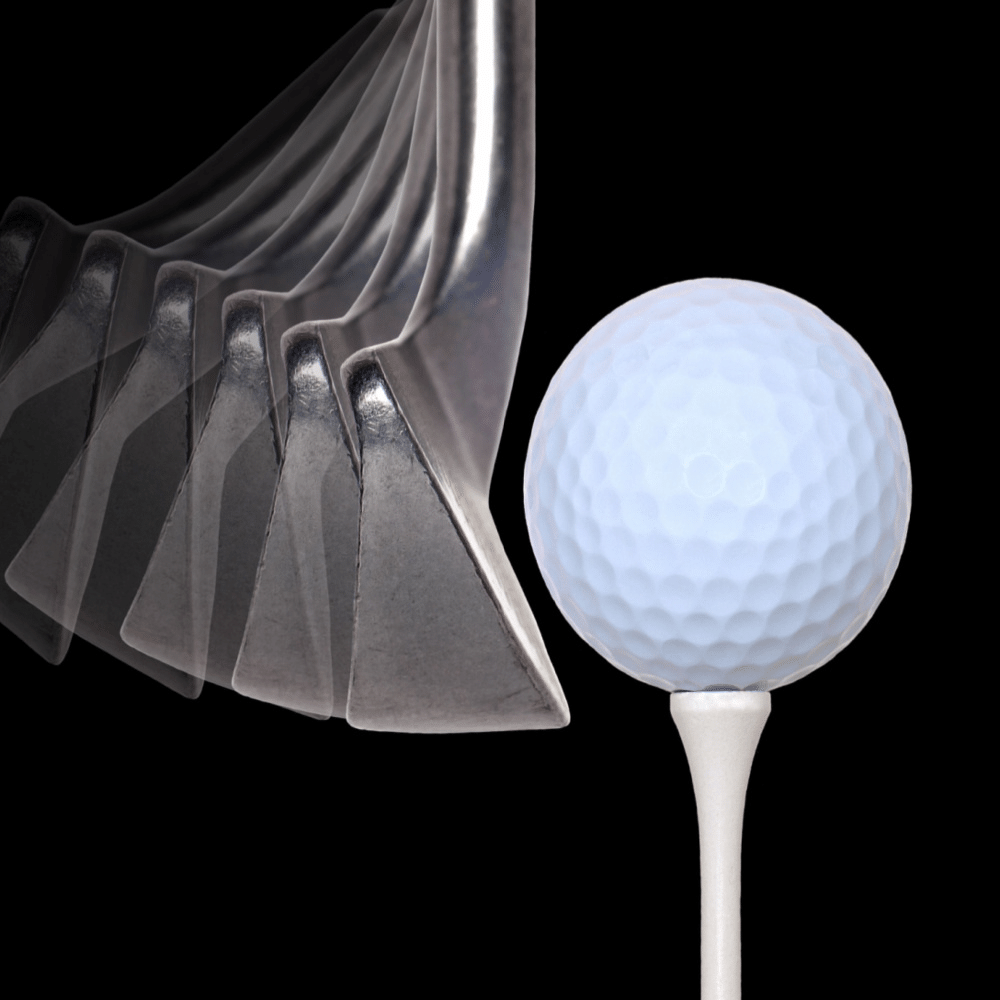Have you ever walked off the 18th hole wondering where it all went wrong? It was one mishit after another - a long troublesome round that you couldn't wait to end. Then that age-old question pops up in your head - is it my swing or is it the clubs? Well, you're not alone. We've all been there.
When it comes to golf clubs, there's no shortage of options out there. Whether your choice is game improvement irons or blades, there's one critical element that should not be overlooked. This can make or break your game. It's the golf shaft flex.
Selecting the right shaft flex isn't just a matter of personal preference; it's a science, deeply intertwined with your unique swing speed. When your golf shaft matches your swing mechanics and swing speed you'll be well on your way to longer drives and better ball striking.
Enter the Comprehensive Golf Shaft Guide where we break it down from swing speed for stiff shaft to the right shaft flex for a slower swing speed and the benefit of steel shafts vs graphite shafts. Imagine this guide as your trusty caddy who also happens to have a Ph.D. in golf shaft technology.
We'll travel back in time exploring the evolution of golf club shafts from the early hickory days to the carbon-fiber masterpieces of today. We'll provide insider tips and provide a golf shaft flex chart that offers a visual guide ensuring that you pair the correct shaft flex with your game.
Now why is this a must-read? Because we're obsessed with golf. We love geeking out over gear, playing endless rounds (going on 45 years strong), and digging into the nitty gritty of it all. We've spent hours decrypting insights from leading industry professionals and days researching what's working for all levels of players. If you want to shave strokes off your handicap and consistently find the sweet spot - this one's for you!
By the end of our journey, you'll be reaching for your clubs with renewed confidence. No more guesswork or relying on what "feels right" – you'll have the knowledge to choose a golf club that truly complements your swing. And of course, you'll know the exact swing speed for a stiff or regular shaft. So, if you're ready to discover your perfect golf shaft let's get started.

Swing Speed and the Golf Shaft Flex Chart: Unlocking Your True Potential
Have you ever felt that there's something missing to your game? One critical element that doesn't always get the attention it deserves is the relationship between your swing speed and the shaft flex of your clubs.
Are you constantly hooking the ball off the tee? If your driver shaft is a regular flex shaft that could be part of the problem. Your swing speed may be too fast and in need of a stiff flex shaft. Understanding this connection could be the key to unlocking a whole new level of play.
Let's find your perfect partner!
The Rhythm of Your Game - Swing Speed
Every golfer has a unique swing speed. Think of it as your golfing fingerprint. This is the velocity measured in mph at which you swing the golf club. It's crucial because your swing speed largely dictates the kind of shaft flex that'll work best for you.
Clubhead Speed: The Moment of Truth
Here's where the rubber meets the road (or should we say where the clubhead meets the ball). This is the moment of impact. It defines your launch angle, trajectory, spin, distance, and more. In other words, you better be playing the correct shaft.
The Golf Shaft Flex Chart - Guiding Your Choice
Here it is - your guide to better golf.
- Extra Stiff (X or XS): Tailored for those with powerful swings, typically over 110 mph.
- Stiff (S): So if you asked the question, What is the ideal swing speed for a stiff shaft? The answer is: It is best suited for swing speeds between 90 mph and 110 mph. For a stiff shaft driver, your swing speed should be between 97 and 104. A stiff shaft 3-Wood should have a swing speed between 93 and 97. For a stiff shaft 6-Iron, you should have a swing speed between 84 mph and 91 mph.
- Regular (R): Ideal for players with swing speeds between 80 and 90 mph.
- Senior (S or M): For those cruising between 70 and 80 mph.
- Ladies (L): Designed specifically for swings below 70 mph.
We also consulted with our friends at Golf Magazine to provide you with this more extensive shaft flex chart:
Choosing the Right Shaft Flex: Exclusive Tips Straight from the Insiders
Ready to get the inside scoop on choosing the perfect golf shaft flex for your swing? Well, you've teed up at just the right hole. Grab your favorite club, settle in, and let's find your perfect golf shaft just like the Pros.
The Golden Rule – Professional Club Fitting
Let's start with an industry secret: if there's one thing you should splurge on in golf, it's a professional club fitting. Remember the last time you went shoe shopping? The size 9 from one brand fit like a dream, but the same size in another brand felt like you were trying to squeeze into Cinderella’s slipper.
Golf shafts? They’re pretty much the same story. It's not just about picking one off the shelf; it's about finding the one. With a professional fitting, you'll get a club that aligns perfectly with your swing mechanics. It's an investment, sure, but the returns? Improved accuracy, distance, better ball striking and hopefully lower scores.
Going DIY: Picking Your Own Shaft
- Know Your Game: Before you start shopping figure out your numbers (you will need a launch monitor or golf simulator for this) - clubhead speed, ball speed, launch angle, spin rate, distance, dispersion... Plus you need to know your strengths and weaknesses - just be honest with yourself!

- Take a Test Drive: You probably wouldn’t buy a car without taking it for a spin, so don’t buy a golf shaft without taking it for a swing. Many golf shops will let you test out different types of shafts. Spend some time at your favorite golf store or driving range and see how different shafts feel, check the distances, and the ball flight. And ultimately, trust your gut.
- Research, Research, Research: Knowledge is power. Spend time online researching reviews, looking up data and numbers. Join golf forums, talk to your local pro, ask your better golfing buddies, visit pro shops, and ask questions.
Regular vs Stiff Shaft – What Shaft Should I Use?
We can't confirm these numbers but we think it's safe to say that over half the golfers out there are playing the wrong shaft flex. So if you're an average to better than average golfer the debate is real - stiff flex vs regular flex. Or is the question will I get more distance from a stiff shaft driver?
Signs You Need a Stiffer Shaft
Your setup is good, your grip is fine, your swing path is in line, tempo consistent BUT... Yes, that's a big but - there's still something wrong. So you start thinking - what shaft should I use?
If these are your symptoms it may be time to switch from a regular shaft to a stiff shaft.
- Pulling it Left or Pulling it Right: Your clubface is closing too quickly leading to constant hooks.
- Ballooning Ball: Your ball flight is too high.
- Where's the Distance: Inefficient energy transfer leading to weak drives.
- Inconsistent Contact: Mishits coming from everywhere due to lack of clubface control.
- Whippy Feeling: No stability - the club feels loose.
- Timing Issues: Your shaft is lagging. You feel a need to slow down your swing to make solid contact.
- Driver Impact: Your ball marks are consistently towards the heel of the driver - not good for driver carry distance.
- Increased Shot Dispersion: You've lost your accuracy.
- Excessive Torque: Too much twisting leading to poor ball striking.
- Soft Feeling Golf Ball: You know it's not the golf ball but it feels almost mushy.
- Where's the Shot Shaping: You've lost your ability to draw or fade the golf ball.
- Excessive Spin: You're spinning the ball off the green with your irons.
When to Switch From Stiff to Regular Shaft?
Playing with a shaft that's too stiff for your swing can be as problematic as one that's too flexible. In fact, you'll see similar signs. Let's take a look.
- Slicing Left or Slicing Right: You're not able to square the clubface at impact.
- Lower Ball Flight: You're struggling with your low-lofted golf clubs to get the ball in the air. The ball flight is always low or flat.
- Where's the Distance: Poor energy transfer.
- Mishit Mayhem: You feel the stinging harshness of your mishits.
- Where's the Draw: No matter how hard you try you just can't seem to turn the ball over.
- Loss of Feel: Your timing and accuracy is poor because you can't feel where the clubhead is.
- Driving off the Toe: When you hit your driver or woods all your ball marks end up towards the toe of the club.
- Heavy Club: You can almost feel the rigidity or stiffness.
- Lack of Spin: You can't hold the green with your irons.

From Wooden Sticks to Tech Wonders: The Historical Evolution of Golf Shafts
Golf shafts have a fascinating history that ties into both the technological advancements of history and the concern of technology overtaking the game. Let’s travel back in time and look look at the significant milestones in the evolution of the golf shaft.
1. The Humble Beginnings (15th century up to the 19th century):
- Wooden Shafts: For centuries, golfers used clubs made entirely of wood. This included the shaft, which was typically hand-crafted by players from hardwoods such as ash, hazel, or other hardwoods.
2.The Late 1700's to the Early 1800's:
- The Hickory Era: According to the Professional Golfers Career Coolege, Robert Forgan, a Scottish club maker, introduced hickory shafts to the world of golf. The year was 1826 and the hickory was coming from America. It quickly became the wood of choice thanks to its durability and attainability.
3. The 1920s and 30s:
- The Steel Revolution: In the early 1920's the game of golf forever changed - the steel shaft was introduced. They were almost 30 years in the making. But the year to remember was 1929. The Prince of Wales used them in a round of golf at St. Andrews. The R&A finally gave steel shafts their blessing - 5 years after the USGA. Not only were they much more durable (meaning they didn't break) but they also proved to increase accuracy. 1929 continued to be a magical year thanks to the creation of a tapered shaft and different shaft flexes. And the company behind it - True Temper. By the mid-1930s, steel shafts had become the standard in professional golf.
4. The 1970s:
- Graphite Shafts: With tech innovations, the early 70s saw the introduction of the graphite shaft. These were lighter than steel, allowing for faster swing speeds. They were stronger and more flexible. They were also easier on the body reducing that stinging vibration felt on bad mis-hits. This was a welcome change for amateurs suffering from injuries like golfers elbow or seniors looking for an easier more forgiving shaft.
5. The Turn of the Millennium:
- Hybrid Shafts: As the golfing world became obsessed with technology, manufacturers began to experiment with combining materials. The industry began to see hybrid shafts marrying the best of two worlds - steel and graphite.
- Nano-Technology: Leveraging the breakthroughs in nano-technology, golf shafts began integrating nano-resins with advanced composites. It was all about more speed, greater durability, better feel, and stability. And all this with less weight.
6. The Modern Day:
- Personalization: It's not like the old days when one size fits all. Today, you can design your own golf shaft by choosing materials, your flex, and kick points - all tailored to your swing and swing speed.
- The Aerodynamic Experiment: More speed means less air resistance, thus the reason the industry is exploring aerodynamic designs.
- The Perfect Fit: Whether you're a PGA Tour Pro working on your game at the range (launch monitor by your side of course) or an amateur using a golf simulator at home stats and data are everywhere. It's easier than ever to analyze all the numbers and dial in the right flex, torque, weight, and length.
Bend It Like a Pro: The Lowdown on Understanding Golf Shaft Flex
If you've watched any game on tv, you've seen the incredible super slow-motion replays of the world's best players' swings. What's amazing is the amount of bend they create with the club shaft. That elastic whip is shaft flex in all its glory. Let's break it down further and understand why it's so important.
The Meaning of Golf Shaft Flex
Simply defined shaft flex is the measure of how much the shaft bends during the golf swing and at that critical moment of impact. A shaft's bendability, or flex, is largely determined by its material and design. For example, graphite shafts should be lighter and more flexible than their steel counterparts.
The degree of flex in the shaft influences the ball's launch angle and the spin rate at the moment of impact. There are different categories of shaft flex from extra stiff to regular to ladies and many more in between. So if you want to maximize your distance and accuracy you need to know if you're better off with stiff flex shafts or regular flex shafts or maybe senior flex shafts.
Now why is this so important?
Why The Significance of Golf Shaft Flex Isn't Just for Pros
How much a golf club shaft bends matters more than you might think. It's key to how the club reacts when striking the ball and how it feels in your hands. Here's why:
- The Springboard Effect: The shaft's flex is all about storing energy as you swing. Then at that beautiful moment when your clubhead meets the golf ball all that energy and power is released. When your swing and golf club shaft flex are aligned the result is better accuracy and greater distance.
- Swing Speed Meets Shaft Flex: Swing speed and shaft flex go hand in hand. Just like a golf balls compression should match your swing speed - the same goes with shaft flex. For all you bombers with high swing speeds stiff shafts are your best bet. They'll help you keep the ball in the fairway. If you have a slower swing speed then a more flexible shaft will help you generate higher ball speed and more driver distance.
- Ball Flight and Elevation: The flexibility of your shaft has a major impact on the balls trajectory and ball flight. It dictates how high or low your ball will travel. With a stiff shaft, you can expect a lower, more penetrating trajectory. But if there's more give in that shaft, your ball might just reach the skies. It's all about matching the flex to your ideal ball flight while providing more control.
- Feedback and Flow: For many of the best golfers in the world golf is a game of feel. Sure we all get obsessed with technique and mechanics but we'll bet that some of your better ball-striking days are when you trust your swing and play by feel. Choosing the right flex allows you to have more feel in your golf swing and trust the natural flow of your swing. This also provides valuable feedback when that unfortunate slice or mishit creeps into your game.

All About Flex: Navigating the World of Golf Shaft Types
Alright, let's dive into the world of golf shaft types and flexes! Understanding the different types of golf shafts is essential if you want to play your best golf. Shaft types and shaft flexes are designed to work with specific swing speeds and different types of swings. Let's take a look at what works for your game. Remember we're looking for extra yards and more greens in regulation
Discover the Best Golf Shaft for Your Game
Tried and True - Steel Shafts
- Tapered Steel Shafts: This stepped-up design is popular with many of the top golf brands. They are known for their consistency, tapering from a thicker grip end to a borrower tip at the clubface.
- Steel Rifle Shafts: Absent of steps, these are slick, smooth shafts from grip to clubface. If you're looking to vary your ball flight you can't go wrong with these high-performance shafts.
The New Standard - Graphite Shafts
- If you're looking to boost your driver swing speed graphite is the lightweight option you need. If you like colorful shafts and more flex choose graphite. Plus they reduce that nasty stinging and vibration on your mishits.
The Next Revolution - Crazy Hybrid Shafts
- A newer addition to the golf shaft scene that combines the best of two worlds - steel and graphite.
High-Tech Wonders - Nanofuse Shafts
- Welcome to the world of cutting-edge nanotechnology - a fusion of metal and nano-resin. Imagine a shaft with the strength of steel and the flexibility of graphite. These shafts offer a lightweight yet robust design, providing golfers with enhanced feedback and performance.
The Player's Choice: Tour Worthy Shafts
- Tour golf shafts are high-end shafts designed specifically for the needs and preferences of professional golfers. These shafts often feature advanced materials and technologies, ensuring optimal performance, consistency, and precision. If you have the game, a super high swing speed and don't mind spending the extra bucks these could be for you.
From Flex to Weight: The A-Z of Golf Shaft Technology
Golf Shaft Flex Ratings
Flex refers to how much a golf shaft bends during the swing.
- Extra Stiff (XS)
Who's it for? Golfers who can ramp up their mph - usually for those who drive the ball at least 260 yards. If you're a Pro or a big bomber with superhuman strength this may be the one for you.
What's the vibe? Provides more control for big bombers with high swing speeds.
- Stiff (S) or Firm (F)
Who's it for? Designed for golfers who drive the ball between 240 and 260 yards. Perfect for many scratch or low handicap golfers.
What's the vibe? It's the sweet middle ground for those who swing hard but they don't come out of their shoes.
- Regular (R)
Who's it for? Perfect for golfers who drive the ball between 210 and 240 yards. Designed for average swing speeds and many mid to high handicappers.
What's the vibe? This is the most common flex and the choice for most amateurs or average golfers combining distance and control.

- Amateur (A)
Who's it for? This one's for the newbie - beginners just learning the game. Your swing speed is in between an average golfer and a senior.
What's the vibe? It's all about adding speed, power and flexibility to a moderate swing speed.

- Senior (S) or M (Mature)
Who's it for? Built for players who drive the ball between 180 and 200 yards.
What's the vibe? Despite the name, it's not strictly for the older crowd. It's all about the swing speed! It offers a bit more flexibility, which can be a boon for those with moderate swing speeds.

- Ladies (L)
Who's it for? Specifically designed for women golfers, typically those who drive the ball 180 yards or less.
What's the vibe? Offers the most flex, which is great for players with slower swing speeds. And remember gents, if this fits your swing speed, there's no shame in using it.

Golf Shaft Torque
In golf, shaft torque is a measure of resistance relating to how much the shaft twists or turns during your golf swing. Typically it ranges in degrees from 2 to 7 degrees. The lower the number the less likely the clubface will rotate at impact. A higher torque will create more clubhead rotation. Remember the goal is to have the clubface square at impact.
Pros and golfers with high speeds opt for a lower torque - less twisting in the shaft. This allows for more control, especially on mishits. If you have a slower swing speed more torque will help the shaft to square itself at impact. The sweet spot for torque ties back to your swing's speed and your comfort preferences.
The Kick-Point (Flex-Point)
Kick-point, often referred to as "bend point" or "flex point," in a golf shaft describes the location where the shaft bends the most during your swing. It affects your launch angle and the golf ball's trajectory. Let's take a look at the three categories of kick-point.
- High Kick-Point: If the shaft has a high kick-point, it will bend more towards the grip. This typically results in a lower ball flight because the clubhead is delofted at impact.
- Mid Kick-Point: A shaft with a mid kick-point will bend toward the middle of the shaft. As you can imagine, this results in a mid-level ball flight. For many golfers, this is ideal. It can be the perfect balance between control and distance.
- Low Kick-Point: This type of shaft will bend more towards the clubhead producing a higher ball flight.
Golf Shaft Weight
When we talk about the weight of a golf shaft, we're talking about how much the shaft weighs, measured in grams. But why does this number matter, and how can it affect your game? Let's break it down:
- The weight of your golf shaft will vary depending on its composition (graphite or steel) and its length.
- Drivers usually tip the scales between 40 to 85 grams.
- Irons shafts can weigh in at a hefty 130 grams or as light as 40 grams.
- Let's turn to our friends at Golf Magazine to sum it up best: A heavy shaft equals less spin and a lower ball flight. A lighter shaft produces more spin and a higher ball flight.
- There's no doubt that the weight of your golf shaft will affect your performance but it's much more about your feel versus trying to match your swing speed.
Flex Fables: The Surprising Truths About Golf Shafts You Never Knew
When it comes to golf shaft flex, numerous myths and misconceptions can lead golfers down the wrong path. Let's clear the air and debunk some of these common myths.
Stiffer Shafts Equal More Distance:
- Myth: Many believe that stiffer shafts will automatically give them more distance.
- Reality: Shaft stiffness should match a golfer's swing speed and swing mechanics. Using a shaft that isn't a match to your swing, whether it's too flexible or too stiff can result in a loss in distance.
High Handicappers Need Regular Flex:
- Myth: If you're a high handicapper, you should be using a regular flex.
- Reality: It's not all about the handicap. It's about swing speed and swing characteristics.
Shaft Flex Doesn’t Matter for Amateurs:
- Myth: Only pros and scratch golfers need to worry about shaft flex.
- Reality: Every golfer, regardless of skill level, can benefit from using the correct shaft flex. It can help with consistency, distance, and accuracy.
Changing Shaft Flex Will Cure All Swing Flaws:
- Myth: If someone is slicing or hooking, they just need to change shaft flex. Or said another way - flexible shafts promote a slice.
- Reality: While shaft flex can influence ball flight, it's not a cure-all. Swing mechanics, grip, set-up, and other factors play a huge role.

High Handicappers Need Regular Flex:
- Myth: If you're a high handicapper, you should be using a regular flex.
- Reality: It's not all about the handicap. It's about swing speed and swing characteristics.

Club Fitting is All About Finding The Right Shaft Flex
- Myth: The Most Important Factor in Professional Club Fitting is Shaft Flex
- Reality: There's no doubt shaft flex is critical. But here's what our friends at Golf Magazine have to say about that: "A golfer’s physical size, arm length, swing speed, consistency, ball flight and feel preferences are all important aspects that go into finding the right driver shaft for you."

The Final Swing: Why The Right Golf Shaft Changes Everything
Well, fellow golf aficionados, our journey through the sometimes complex world of golf shafts and flexes has come to an end The one undeniable takeaway? The power of the right shaft flex. It shouldn't be just a consideration; it's fundamental to playing better golf. Choosing the perfect match is like fine-tuning a musical instrument, adding harmony and precision to every swing.
We've delved deep, from the wisdom-filled insights of insiders to the invaluable golf shaft flex chart, which we hope serves as a compass guiding you with the right choice. But remember, charts and articles can only take you so far. There's an art and a science to this, and a professional club fitting brings both into play. It offers that tailored experience, ensuring your golf club resonates perfectly with your unique swing.
In wrapping up, we encourage you to pause and reflect on our exploration of golf club technology. Golf isn't just a sport; it's a commitment and a way of life. By investing time in understanding and selecting the right shaft, you're setting up your round for longer drives, more greens in regulation, and more birdie putts.
Thanks for visiting. We can't wait to see you again!
"Keep it in the short grass"
Joseph











Member discussion